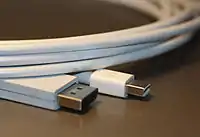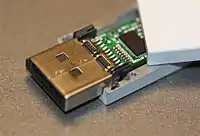Active cables are copper cables used for data transmission that use an electronic circuit to boost the performance of the cable. Without an electronic circuit, a cable is considered a passive cable. Passive cables are prone to data degradation from channel impairments, including attenuation, crosstalk, and group velocity distortion. In active cables, a circuit using one or several integrated circuits is embedded in the cable to compensate for some or all of these impairments. This active boosting allows cables to be more compact, thinner, longer, and to transmit data faster than passive cables.
Active cables are used in enterprise networks, which are common in modern data communication systems. They are also used to connect consumer devices such as cameras, gaming consoles, and HDTVs.
Embedding circuitry in cables can allow for less copper to be used in cable production while still retaining performance, reducing the weight of the cable by as much as 80%, and reducing cable size. Other benefits include longer reach and lower power consumption.[1][2]
Consumer electronics
DisplayPort is the latest consumer electronics standard that has enabled support for active cables by allocating power supply pins inside the connector. Active DisplayPort cables enable ultra-thin (32 AWG and thinner) and long-reach interconnects which are particularly valuable for use with the miniature Mini DisplayPort form-factor.[3]
Enterprise and storage applications
Active cables play an important role in enterprise and storage applications due to the confined space and air-flow requirements in data centers and the long reaches (typically up to 30 meters) required to make some of the rack-to-rack connections. Active cables can accommodate thin cable gauges and have a tighter bend radius, which can give cables in these applications more manoeuvrability and improve airflow.
As of 2010, half of SFP+ interconnect volume is in active cables (as opposed to passive copper cables and optical transceiver modules).[4] In addition to this, the advent of QSFP (Quad SFP) interconnects for 40 Gigabit Ethernet and InfiniBand is driving the widespread adoption of active cables in this form-factor.
Standards
Criticism
Opponents of active cable technology often criticize the fact that the electronics in an active cable design could be placed inside the connected devices. Digital alternatives to using analog equalizers and impedance matching circuits to improve cable performance also exist, such as channel estimation or link adaptation.
Another criticism of active cables is that manufacturers may patent the electronics inside an active cable or even utilize on-chip cryptography to prevent competitors or consumers from producing their own replacement cables. Active cables typically cost 5 to 10 times more than passive cables.[12] Some active cables are only produced by a single manufacturer, and sold through a single distributor. Low cable cost and high availability is desirable because cables are often inadvertently lost or damaged.
Some opponents of active cables also believe that active cables do not provide power savings for signal processing reasons; because in an active cable design, there is at least one extra integrated circuit (IC) compared to passive cable designs. This extra IC must be powered separately, when in a passive cable design, the signal processing can be integrated onto a single chip.
See also
- 10 Gigabit Ethernet
- 100 Gigabit Ethernet
- C form-factor pluggable
- Cloud computing
- CXP (connector)
- Data center
- Fiber-optic communication
- Fibre Channel
- Green computing
- HDMI
- High-performance computing
- Interconnect bottleneck
- List of device bandwidths
- Optical cable
- Optical communication
- Optical link
- Optoelectronics
- Parallel optical interface
- PCI Express
- Small form-factor pluggable transceiver
- Terabit Ethernet
- Thunderbolt
References
- ↑ G. Oganessyan, Active Cable Interconnects for High-Speed Serial Communications, DesignCon Conference proceedings, February 2010
- ↑ DisplayPort Alt Mode 2.0 Spec Released
- ↑ Intersil Unveils Long-Haul Mini DisplayPort Video HyperWall Interconnects, January 2010
- ↑ Where will the Chips Land? – Future of Active Copper and Active Optical Networking Cable Assemblies, archived from the original on 2010-08-16
- ↑ "InfiniBand Trade Association". InfiniBand Trade Association. Retrieved 2023-04-24.
- ↑ "T10 Technical Committee". www.t10.org. Retrieved 2023-04-24.
- ↑ "DisplayPort | High Performance Digital Technology". DisplayPort. Retrieved 2023-04-24.
- ↑ "Welcome to PCI-SIG | PCI-SIG". pcisig.com. Retrieved 2023-04-24.
- ↑ "HDMI Licensing Administrator, Inc". www.hdmi.org. Retrieved 2023-04-24.
- ↑ "Front Page | USB-IF". www.usb.org. Retrieved 2023-04-24.
- ↑ "Thunderbolt Technology: A Universe of Possibilities". Intel. Retrieved 2023-04-24.
- ↑ Apple Thunderbolt Cable

